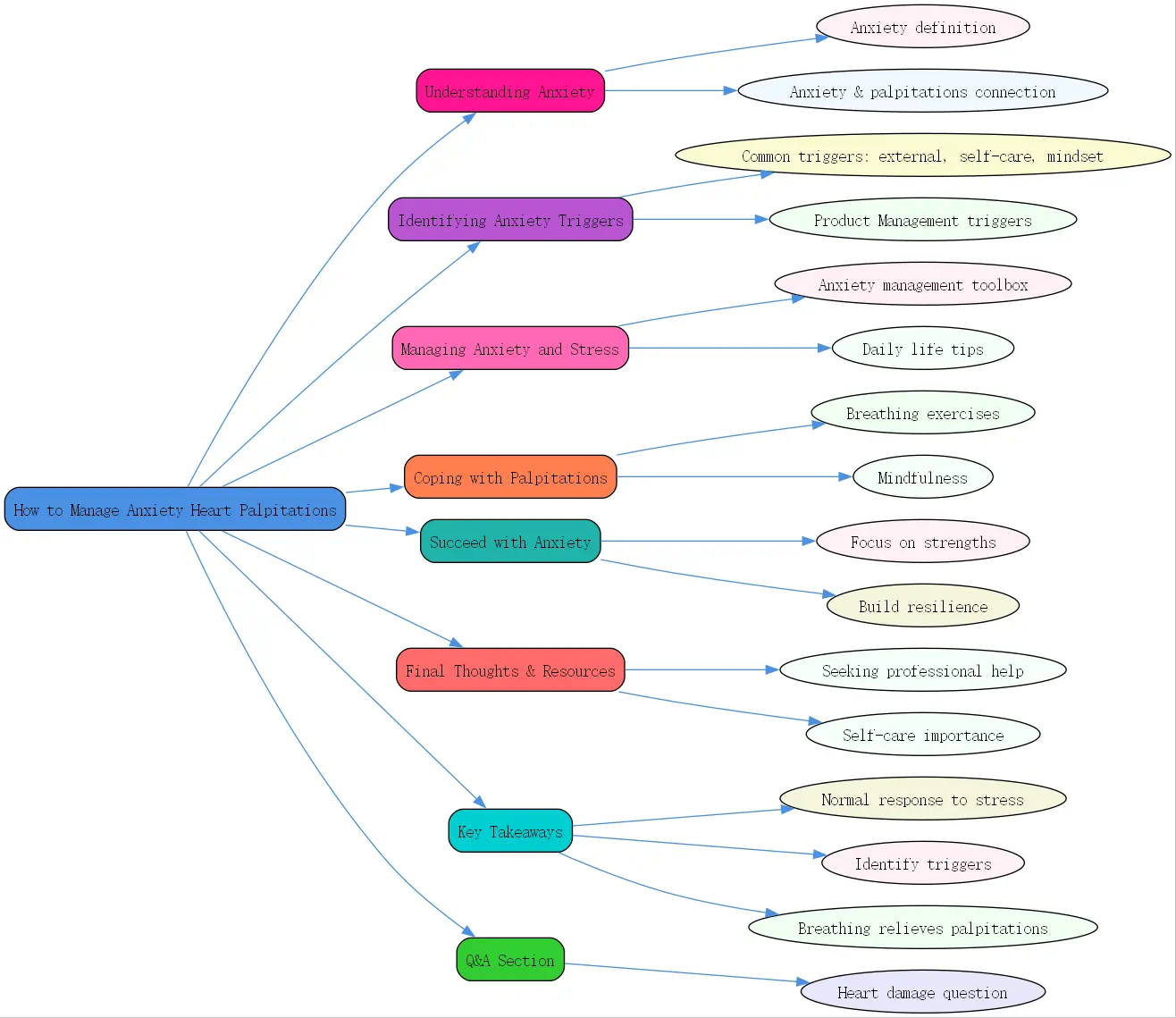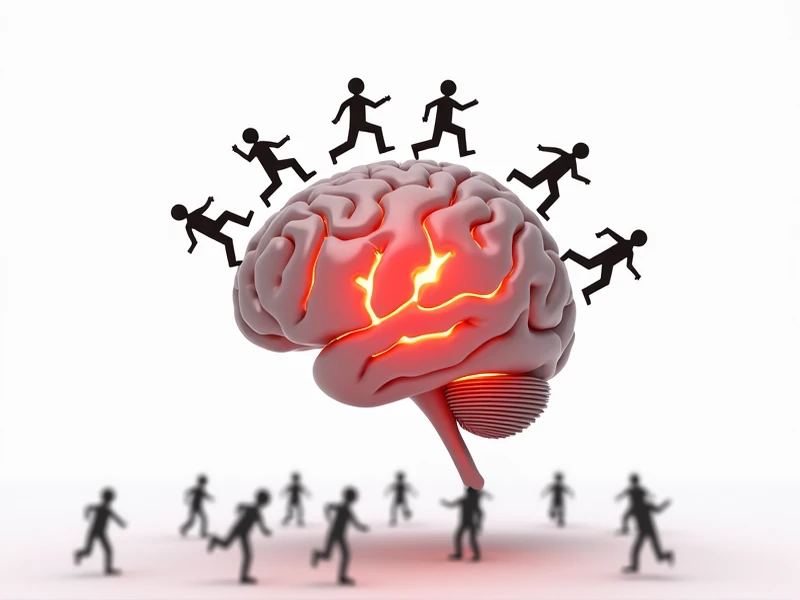Understanding Anxiety and Heart Palpitations

Defining Anxiety: Intense Worry and Fear
Anxiety is characterized by intense, excessive, and persistent worry and fear about everyday situations. According to the Mayo Clinic, anxiety manifests through both psychological and physical symptoms that can significantly impact daily functioning. When we experience anxiety, our bodies enter a heightened state of alertness, triggering our “”fight or flight”” response even when no immediate danger exists.

For many individuals, anxiety isn’t just a mental experience鈥攊t creates very real physical sensations that can be alarming and distressing. These physical manifestations often become anxiety triggers themselves, creating a challenging cycle that can be difficult to break without proper management techniques.
The Connection Between Anxiety and Heart Palpitations
One of the most frightening physical symptoms of anxiety is heart palpitations鈥攖he sensation that your heart is beating too hard, too fast, or skipping beats. Learning how to manage anxiety heart palpitations begins with understanding this connection. When anxiety strikes, your body releases stress hormones like adrenaline, which increase your heart rate and blood pressure as part of the body’s natural stress response.
Heart palpitations can feel like your heart is pounding, fluttering, or racing. While usually harmless in the context of anxiety, these sensations can be extremely uncomfortable and often intensify anxiety, creating a feedback loop where fear of palpitations causes more anxiety, which in turn causes more palpitations.
Generalized Anxiety Disorder and Its Impact
Generalized Anxiety Disorder (GAD) involves severe, ongoing anxiety that interferes with daily activities. People with GAD experience excessive worry about ordinary events and situations, often anticipating disaster even when there’s little reason for concern. This constant state of worry can lead to chronic physical symptoms, including persistent heart palpitations.
The impact of GAD extends beyond momentary discomfort鈥攊t can affect sleep quality, concentration, energy levels, and overall quality of life. Understanding this condition is crucial for developing effective management strategies that address both the psychological and physiological aspects of anxiety.
Identifying Anxiety Triggers
Common Anxiety Triggers: External Factors, Self-Care, and Mindset
Anxiety triggers fall into three main categories: external factors, self-care practices, and mindset patterns. External triggers include family dynamics, health concerns, financial pressures, and global events. Self-care factors encompass nutrition, sleep quality, exercise habits, screen time, and general stress management. Mindset triggers involve fixed thinking patterns, learned helplessness, blame, shame, avoidance behaviors, and defensive posturing.
Identifying your personal triggers is the first step toward developing effective strategies for how to manage anxiety heart palpitations. By recognizing what sets off your anxiety, you can begin to implement targeted interventions before symptoms escalate.
Product Management Specific Anxiety Triggers: A Detailed Look
While the reference text focuses on product management professionals, these workplace triggers translate across many professional environments. High-pressure situations like interviews, role misalignment, stakeholder management, product launches, and time management challenges can trigger anxiety in various career contexts.
Understanding these professional anxiety triggers helps contextualize workplace stress and develop targeted coping mechanisms. Whether you’re balancing competing priorities, facing performance pressure, or managing interpersonal dynamics, recognizing these triggers allows you to prepare appropriate responses.
Interviewing, Role Fit, and Balancing Stakeholder Needs
Professional situations that demand on-the-spot thinking and performance can significantly trigger anxiety. When faced with high-stakes interviews or presentations, many people experience increased heart rate and palpitations. Similarly, finding yourself in a role that doesn’t align with your skills or strengths can create chronic anxiety that manifests physically.
The challenge of balancing multiple stakeholders’ needs鈥攚hether clients, team members, or management鈥攃reates ongoing pressure that can trigger anxiety symptoms. This constant juggling act requires emotional regulation skills to prevent anxiety from interfering with decision-making and performance.
Time Management, Interpersonal Relations, and Performance Anxiety
Time management challenges, including overwhelming to-do lists and competing priorities, frequently trigger anxiety symptoms. When deadlines loom and demands increase, heart palpitations often follow. Similarly, difficult interpersonal dynamics, including microaggressions, gaslighting, or trust issues, create emotional stress that manifests physically.
Performance anxiety extends beyond public speaking to creative blocks and strategic thinking pressure. The expectation to consistently perform at high levels can trigger anxiety symptoms, particularly when you feel responsible for outcomes beyond your control.
Cognitive Load and Decision Fatigue
The modern workplace often demands continuous learning and adaptation, creating cognitive load that can trigger anxiety. Technology professionals particularly face the pressure of keeping pace with rapidly evolving fields. This constant need to learn and master new skills can create anxiety that manifests as heart palpitations and other physical symptoms.
Decision fatigue鈥攖he deterioration of decision-making quality after making many decisions鈥攕imilarly triggers anxiety symptoms. As mental resources deplete throughout the day, anxiety often increases, creating physical manifestations like heart palpitations, especially when decisions carry significant consequences.
Effective Strategies to Manage Anxiety and Stress
Building Your Anxiety Management Toolbox
Developing a personalized anxiety management toolbox is essential for addressing anxiety heart palpitations effectively. This toolbox should include a variety of techniques that work for your specific triggers and symptoms. At BrainTalking, we recommend starting with awareness鈥攔ecognizing your anxiety triggers and physical responses before they escalate.
Your anxiety management toolbox might include breathing exercises, grounding techniques, cognitive reframing strategies, physical movement, and social support mechanisms. The key is having multiple options available, as different situations may require different approaches to effectively manage anxiety symptoms.
How to Manage PMS Anxiety: Specific Techniques
PMS anxiety presents unique challenges due to hormonal fluctuations that can intensify anxiety symptoms, including heart palpitations. Learning how to manage PMS anxiety involves tracking your cycle to anticipate vulnerable periods and implementing preventative measures before symptoms intensify.
Specific techniques include prioritizing quality sleep during the luteal phase, maintaining stable blood sugar through regular, balanced meals, and moderating caffeine and alcohol consumption. Gentle exercise like yoga or walking can help regulate hormones and reduce anxiety symptoms. Some women also benefit from supplements like magnesium, vitamin B6, or calcium, though consulting healthcare providers before starting any supplement regimen is recommended.
Tips to Manage Anxiety and Stress in Daily Life
Incorporating anxiety management into daily routines creates resilience against stress triggers. Effective tips to manage anxiety and stress include establishing morning and evening rituals that promote calm, scheduling regular breaks throughout the day, and practicing mindfulness during routine activities like eating or walking.
Setting boundaries around technology use, particularly before bedtime, helps regulate stress hormones. Regular physical activity鈥攅ven brief movement breaks鈥攔educes anxiety by releasing tension and promoting endorphin production. Prioritizing social connections and seeking support when needed prevents isolation that can intensify anxiety symptoms.
How to Manage ADHD and Anxiety: Integrated Approaches
The combination of ADHD and anxiety presents unique challenges that require integrated management approaches. Understanding how to manage ADHD and anxiety together involves recognizing how these conditions interact鈥擜DHD symptoms can trigger anxiety, while anxiety can exacerbate ADHD symptoms, creating a challenging cycle.
Effective strategies include creating structured environments that reduce ADHD-related stress, breaking tasks into manageable steps to prevent overwhelm, and using visual aids and reminders to reduce cognitive load. Mindfulness practices modified for ADHD (shorter duration, movement-based options) help manage both conditions simultaneously. For many individuals, professional support from practitioners familiar with both conditions provides essential guidance for integrated management.
Coping Mechanisms for Anxiety Heart Palpitations
Breathing Exercises for Calming Heart Palpitations
When experiencing anxiety heart palpitations, breathing exercises provide immediate intervention by activating the parasympathetic nervous system. The 4-7-8 breathing technique (inhale for 4 counts, hold for 7, exhale for 8) effectively reduces heart rate and alleviates palpitations. Similarly, diaphragmatic breathing鈥攂reathing deeply into the belly rather than shallowly into the chest鈥攃ounteracts the rapid, shallow breathing pattern associated with anxiety.
Practicing these techniques regularly, not just during anxiety episodes, strengthens your ability to implement them effectively when needed. BrainTalking recommends daily breathing practice as preventative maintenance for anxiety management.
Mindfulness and Meditation Techniques
Mindfulness and meditation practices build awareness of physical sensations without judgment or reaction, helping break the anxiety-palpitation cycle. Body scan meditations particularly help identify early physical signs of anxiety before they escalate to heart palpitations. Regular meditation practice has been shown to reduce anxiety sensitivity鈥攖he fear of anxiety-related sensations鈥攚hich often drives heart palpitation anxiety.
Even brief mindfulness practices (3-5 minutes) throughout the day can significantly reduce anxiety levels. Guided meditations specifically designed for anxiety management provide accessible entry points for beginners while offering structured support during high-anxiety periods.
Physical Activities to Reduce Anxiety
Regular physical activity significantly reduces anxiety sensitivity and helps manage heart palpitations through multiple mechanisms. Exercise releases tension from muscles, regulates stress hormones, and improves cardiovascular health, making the heart more resilient to stress responses. Activities like walking, swimming, yoga, and tai chi particularly benefit anxiety management through their rhythmic, meditative qualities.
The key is finding enjoyable activities that you’ll maintain consistently, as regularity provides greater anxiety management benefits than intensity. Even brief movement breaks throughout the day鈥攕tretching, walking, or gentle yoga鈥攃an prevent anxiety accumulation and reduce heart palpitation episodes.
Can You Succeed with Anxiety?
Focusing on Your Strengths and Passions
Despite anxiety challenges, focusing on your strengths and passions creates resilience and purpose that counterbalance anxiety’s impact. Identifying activities where you experience flow鈥攃omplete absorption in engaging, challenging tasks鈥攑rovides respite from anxiety while building confidence and competence.
BrainTalking encourages clients to regularly engage with their strengths and passions, even briefly, during high-anxiety periods. This connection with personal strengths reminds you of your capabilities beyond anxiety and creates positive emotional experiences that buffer against stress.
Reflecting on What Energizes You
Reflection on what energizes rather than depletes you provides essential guidance for managing anxiety long-term. Activities, environments, and relationships that consistently energize you often contain clues about your optimal functioning conditions. Creating more opportunities for these energizing experiences while minimizing depleting ones improves anxiety management capacity.
This reflection process isn’t about eliminating all challenges but about creating sustainable patterns that support resilience. Understanding your personal energy patterns helps structure daily routines that minimize unnecessary anxiety triggers while building resources for managing unavoidable stressors.
Turning Anxiety into a Source of Resilience
With appropriate management, anxiety can become a source of resilience rather than limitation. Many successful individuals channel anxiety’s energy into preparation, attention to detail, and empathy for others鈥攖ransforming potential limitations into professional strengths. This perspective shift doesn’t deny anxiety’s challenges but reframes them as potential contributors to success.
Learning how to manage anxiety heart palpitations and other symptoms builds self-efficacy that transfers to other life challenges. Each successful anxiety management experience strengthens your confidence in handling future difficulties, creating a positive cycle of growing resilience.
Final Thoughts and Resources
Seeking Professional Help When Needed
While self-management strategies significantly improve anxiety symptoms, professional support remains essential for many individuals. Therapists specializing in cognitive-behavioral therapy (CBT), acceptance and commitment therapy (ACT), or mindfulness-based stress reduction (MBSR) provide evidence-based approaches for anxiety management. Psychiatric evaluation may benefit those with severe or treatment-resistant anxiety.
Remember that seeking professional help represents strength, not weakness. BrainTalking advocates for combining self-management techniques with professional guidance when needed for comprehensive anxiety management.
Additional Resources for Anxiety Management
Numerous resources support ongoing anxiety management beyond professional treatment. Evidence-based apps like Headspace, Calm, and Woebot provide accessible tools for daily anxiety management. Books such as “”The Anxiety and Phobia Workbook”” by Edmund Bourne and “”Dare”” by Barry McDonagh offer structured approaches to understanding and managing anxiety symptoms.
Online communities provide valuable peer support while reducing isolation that often accompanies anxiety. However, ensure these communities maintain positive, solution-focused approaches rather than reinforcing anxiety patterns.
The Importance of Self-Care and Continuous Learning
Effective anxiety management requires ongoing self-care and learning rather than one-time interventions. Regular sleep, nutrition, exercise, and social connection create the foundation for anxiety resilience. Continuous learning about your personal anxiety patterns and management techniques builds an increasingly effective personalized approach.
Self-compassion throughout this process recognizes that perfect anxiety management isn’t the goal鈥攊mprovement and recovery from setbacks demonstrate success. As you develop expertise in managing your anxiety, including heart palpitations, you’ll discover increasingly subtle early intervention points that prevent major episodes.
Key Takeaways
- Heart palpitations during anxiety are normal physical responses to stress hormones
- Identifying personal anxiety triggers allows for targeted management strategies
- Breathing exercises and mindfulness techniques provide immediate relief for anxiety heart palpitations
- Regular physical activity significantly reduces anxiety sensitivity and heart palpitation frequency
- Professional support combines effectively with self-management techniques for comprehensive anxiety care
- Anxiety management is an ongoing practice that builds resilience over time
Q&A Section





